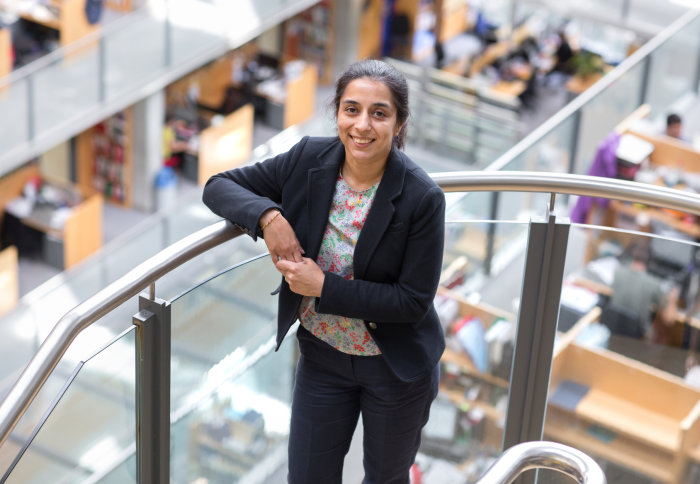Meet Professor Sejal Saglani: Head of Section with NHLI

Professor Sejal Saglani is head of the Inflammation, Repair and Development Section at the National Heart and Lung Institute (NHLI).
Professor Sejal Saglani completed her undergraduate degree in medicine at the University of Leicester before undertaking clinical specialist training in Respiratory Paediatrics. Her postgraduate degree was with the NHLI investigating the pathology of severe infant and preschool wheeze. Professor Saglani took over as Head of the Inflammation, Repair and Development (IRD) Section in 2018, when Professor Clare Lloyd stepped down as lead, and is also an Honorary Consultant in Paediatric Respiratory Medicine, at the Royal Brompton Hospital.
"I’m really proud that our section has lots of young, bright investigators, I hope to be able to keep this momentum going and maintain a section that is attractive, full of lots of learning, but also a welcoming and enjoyable place to work." Professor Sejal Saglani
Professor Saglani’s research investigates severe preschool wheeze, progression to school-age asthma and childhood severe asthma. She has established a translational research programme involving an integrated approach using airway samples from children coupled with an age appropriate neonatal mouse model, and direct application and clinical translation of her findings in interventional clinical trials.
The IRD Section’s research interests include the immunobiology of leukocytes and their interaction with lung tissue, along with the study of asthma, chronic obstructive pulmonary disease, cystic fibrosis, interstitial lung diseases, respiratory infections and acute respiratory distress syndrome.
I caught up with Professor Sejal Saglani to find out more about her and her research.
What is your research about?
My research focuses on investigating the mechanisms underlying severe wheezing in preschool children and severe asthma on older children and finding novel therapies for both conditions. I am also investigating the pathways that lead to the development of early-life structural changes in the airways (remodelling) and the factors that determine the progression of wheezing in pre-school children to school-age asthma. The goal is to find interventions that are disease modifying and will alter the natural history of the disease.
Why did you become a scientist?
I enjoy being able to ask important questions and designing experiments that might answer them, and I really enjoy looking at data and working out what it means and how to move forward with next steps.
What is your most exciting project at the moment?
I am setting up a clinical trial being run at ten severe asthma centres nationally, comparing the efficacy and mechanism of action of two biological add-on treatments for children with very severe asthma (the TREAT trial), funded by NIHR. This is the first trial to directly compare efficacy of two biologics and the largest clinical trial of severe asthma children in the UK.
How do you balance clinical and research responsibilities? What are the benefits?
It is a difficult balance, but I try to ensure I have set days for clinical and academic work, I also have an office away from the hospital, near my lab, this allows me to focus on academic work when I am away from the hospital.
There are numerous benefits, including being able to understand the most important clinical problems and questions that need addressing from the current unmet clinical need. Also, the ability to talk to patients about what they think are important research topics and to be able to recruit patients for clinical studies. My research also involves pre-clinical experimental models, and these can be adapted and made relevant to reflect the clinical scenario.
What is on the horizon for the Section?
I’m really proud that our section has lots of young, bright investigators, I hope to be able to keep this momentum going and maintain a section that is attractive, full of lots of learning, but also a welcoming and enjoyable place to work.
Have you been involved in any aspects of NHLI outside of research?
I am involved in public engagement, specifically making families of children under five years aware of the importance of lung health and breathing. This is via a Wellcome Trust Strategic award investigating mechanisms of onset of preschool wheeze, for which Andrew Bush and Clare Lloyd in the section are PIs. We are working with OKIDO, the Science and Arts magazine and have generated a print version of the OKIDO magazine that focuses on breathing and the lungs. We have also created an animation production called “Itchy, sneezy, wheezy” for Messy goes to OKIDO, which has been aired on CBeebies. Our public engagement project is part of the Breathing Together study and is among the first to engage children under five and their families in learning about science and breathing.
Who inspires you?
I am surrounded by lots of inspirational people. My clinical colleagues inspire me as they are so dedicated to their work, they work hard and always have the patient at the centre of their work. My scientific colleagues, especially some of the younger investigators that we have in the section, are also hugely inspirational. They have some really excellent ideas, communicate their data in very interesting ways and are all hugely talented and intelligent. My patients and families are also a huge source of inspiration and motivation, they are living with really severe conditions, but despite this, manage to continue and appreciate the efforts made to help them.
What do you get up to outside of work?
The only TV programmes I watch tend to be cooking shows, I’ve just finished watching Best Home Cook - I really enjoyed that. I have also been watching Living on the Veg, which is great as I’m a vegetarian. I’m reading George Orwell’s Animal Farm, I guess Brexit made me want to read it again…! To relax, I spend time with my family, I try to run and enjoy cooking.
Article text (excluding photos or graphics) © Imperial College London.
Photos and graphics subject to third party copyright used with permission or © Imperial College London.